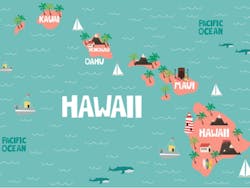What Are the Best Locations for Microgrids? Hawaii Is Mapping Them.
In an effort to spur microgrid development, Hawaiian Electric is working with the US Department of Energy (DOE) and other partners to develop a microgrid map that pinpoints areas across its service territory that are ideal for the technology.
By Mio Buono/Shutterstock.com
Project developers can use the map to contact potential microgrid participants and work with Hawaiian Electric to apply for specific microgrid projects, according to the utility.
The initiative is part of the DOE’s Energy Transitions Initiative Partnership Project (ETIPP), which, in its initial round, is helping 11 remote and island communities to reduce energy costs and power outages.
The map will show areas that have promise for microgrids from a technical and practical point of view, according to Hawaiian Electric.
Microgrids are best suited to areas prone to prolonged weather-related outages, with clusters of customers and potential availability of renewable energy resources, the utility explained after being selected by the DOE for the project.
The mapping project initially focused on the island of Oahu, but Hawaiian Electric expects to expand it to also cover Maui, Hawaii, Lanai and Molokai, the DOE said Aug. 26.
“What we want to do is enable our customers to quickly be able to know what kind of solutions are out there for them,” said Ken Aramaki, Hawaiian Electric’s senior advisor of planning and technology.
Hawaiian Electric proposed the mapping project with the support of the Hawaii State Energy Office, the Division of Consumer Advocacy and the Ulupono Initiative, a nonprofit group focused on making Hawaii more self-sufficient. It is expected to last up to 18 months.
Signaling Hawaii’s interest in microgrids, earlier this year the state established a microgrid tariff, which set rules around microgrids during emergency conditions.
The tariff applies to Hawaiian Electric and its subsidiaries, Hawaii Electric Light and Maui Electric, which serve about 95% of Hawaii’s population.
The Hawaii Public Utilities Commission has moved into a second phase of its microgrid initiative, looking at rules for operations in nonemergency situations, including payment for services microgrids can provide and power purchase agreement models.
Through the ETIPP, the DOE is also working with Kauai County, Hawaii’s fourth largest island, to help it move away from fossil-fuel powered single occupancy vehicles toward a cleaner transportation system.
The efforts come as Hawaii has been looking to become less dependent on fossil fuels while creating a more resilient grid. The state’s renewable portfolio standard climbs to 40% by 2031, 70% by 2041 and 100% by 2046.
